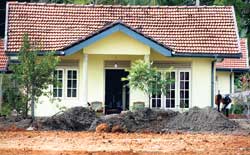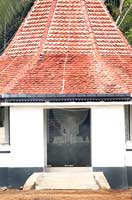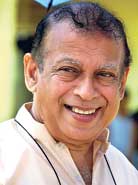
Little Hampton in Lanka~ A Sri Lankan living in Britain has initiated a whole village for tsunami-affected families. The village is astir, with the morning’s routine taking place. The women are sweeping their tiny front-yards. Freshly washed clothes sway in a mild breeze. Dogs sun themselves while toddlers peep out of the doorways of dainty little cottages. Just another village, or is it? Away from not only the madding crowd but also from the southern coastline, wending our way about five km inland from the Ahangama junction, through green paddyfields, the eye suddenly falls on a strange name.
‘Hampton Village’ proclaim the large letters at the gateway to a vast area, five acres to be precise, fringed not only by a wall but also by large trees, providing a haven. Inside the secure area, a playground is taking shape bordered by young pihimbiya and ehela trees, flanked by three prominent constructions. The rows and rows of neat cottages, 50 in all, cover the other area. The germ of an idea for Hampton Village-Sri Lanka had taken root, way back in January 2005, across the seas in England and two weeks before its official opening on December 15, this year, The Sunday Times was meeting the man behind the project. Dubbed a “visionary” by his friends and colleagues, Dr. Upali Wickrama-Sekera, is walking around his creation, armed with a large umbrella against the burning morning sun, greeting with “Ayubowange”, Hampton’s villagers who step out of their homes, sans numbers but with names such as ‘Margaret Thatcher’, ‘Isaac Newton’, to give him little bits of information about a son, a wife, how they have recovered from an illness…... The villagers are in for a pleasant surprise when the Chairman of the English Cricket Board declares open the main street of Hampton as ‘Lord’s Mawatha’, on Saturday. It was January 2, 2005, and Dr. Wickrama-Sekera was cosily ensconced in his living room in Hampton Village in England, having a drink with a friend, when the images of death, despair and devastation of the tsunami unfolded before his very eyes on television. “Those faces of men, women and children pulled at my heartstrings,” he says, with a thought-wave coming to his mind. Not only did he feel for them as a Sri Lankan but also more so as his own ancestral village was Talpe in the south. For him the thought-wave got bigger and bigger and he wanted to do something different, something that nobody else had done before and in April 2005, he took up the challenge of creating Hampton Village-Sri Lanka. The project has been set up under a four-member Board of Trustees in England, of which the patron is Dr. Vincent Cable, Acting Leader of the Liberal Party, UK, with four Sri Lankan Trustees handling the work here. Founder-member Dr. Wickrama-Sekera is Chairman of both Boards.
“I just wanted to build 10 homes for 10 families affected by the tsunami,” says Dr. Wickrama-Sekera, sweepingly taking in the five acres and all buildings that Hampton Village has now become -- fifty houses, a monument, a place of worship and a community centre and pavilion. Of the 50 houses, 43 have been given to families affected by the tsunami while one is for the Trustees or donors whenever they visit and four for British students who undertake case studies of the tsunami. One has also been allocated for volunteer teachers who will teach English to children in the area and the last one will be the health clinic.“All houses are the same,” says Dr. Wickrama-Sekera, explaining that built in the cottage-style, they consist of a hall, two bedrooms, pantry and bathroom with commode and not squatting pan. The only difference in the home allocated for the Trustees is that it has hot water, he smiles. Going back to the beginnings of Hampton Village-Sri Lanka, Dr. Wickrama-Sekera who now lives in retirement in England says once he decided on the project, he signed a Memorandum of Understanding with the Sri Lankan government that the beneficiaries would be chosen from the state list with the Trustees having control of the selections. He believes Hampton Village is the only tsunami trust incorporated by a bill of Parliament which is at the third-reading stage. After two attempts to secure land from the government proved futile, he decided to buy the land himself and set very strict selection criteria for those who would be the beneficiaries. Lower middle income families affected by the tsunami faced a major problem in finding homes in suitable environments. They did not have anyone to turn to. Therefore, Hampton Village targeted just that group. “We looked for families with about two children in the lower middle income category who aspired to develop themselves and also the village, with hopes of educating the children so that they would have a better future,” says Dr. Wickrama-Sekera. That’s how Hampton Village has the right mix of public sector employees such as teachers, police officers and others, with the selection being on a tight marking scheme, to get the right 43 families from Habaraduwa, Weligama, Ahangama and Galle, out of 700 applications. Sixty percent of the residents hold a degree or a higher qualification. A five-member panel sat at the interviews which sometimes lasted as long as one hour. However, although the families are in occupation now, they will not own the homes for five years.
“They have to prove that they are worthy residents of Hampton Village,” says Dr. Wickrama-Sekera. Only then will the homes be transferred to their names but with specific conditions. They will not be able to rent, sell or mortgage the houses without the approval of the Trustees. “These conditions will help keep the basic complexion of the village.” For the sustainability of Hampton Village, every minute detail has been looked into. A Management Association comprising the 43 chief householders as ‘members’ with voting rights to elect the Management Committee and the other 131 residents as ‘associate members’ has been formed to look after the affairs of the village. Each family has to pay Rs. 1,000 a month to a fund which will be utilized for maintenance work and to support families during a funeral, hospitalization or other such emergencies. “They can also turn to the Trustees, we’ll be there for them,” assures Dr. Wickrama-Sekera. The Disciplinary Committee, Good Housekeeping Committee, Development Committee and Sports Committee will also ensure the welfare of the villagers, with the Education Committee providing bursaries for schoolchildren. The funding for this huge project, started as a “tall order”, with people, schools and organizations in the Hampton Village in England being mobilized. The schoolchildren sold badges, everyone chipped in, says Dr. Wickrama-Sekera pointing out that a Principal in a school in the area who had sported a beard for 30-odd years decided to shave it off and let people pay and watch. “They charged a pound each and from that alone we raised 4,000 pounds,” he says, adding that there was a lot of fun and laughter. Both local and British organizations like the Grantham Rotary Club of England, the Kiwanis Club of Colombo and the D.S. Foundation funded the construction of houses while Dr. Upali himself went on lecture tours to schools.“The administrative costs and the construction costs of the monument were totally borne by me,” says this Sri Lankan who left here at 18 and made it good in the UK.
Joining Unilever as a management trainee in England and rising within the company for 11 years, he later moved to British Airways where he worked for 12 years. From then on, headhunted by many a company he became a “company doctor” changing the culture of companies, turning their fortunes around, making them more profitable. It is this same drive that made him undertake the Hampton Village project, with wife Cherrie who left her job as an accountant to work by his side on his heart’s desire. Both now shuttle between Sri Lanka and England where their only daughter is a consultant medical doctor. With the vision of seeing a Hampton child ending up at one of the world’s leading universities, and the village itself becoming a model in Sri Lanka, Dr. Wickrama-Sekera sees it only as “my contribution to my country”. |
|| Front
Page | News | Editorial | Columns | Sports | Plus | Financial
Times | International | Mirror | TV
Times | Funday
Times || |
| |
Reproduction of articles permitted when used without any alterations to contents and the source. |
© Copyright
2007 | Wijeya
Newspapers Ltd.Colombo. Sri Lanka. All Rights Reserved. |


